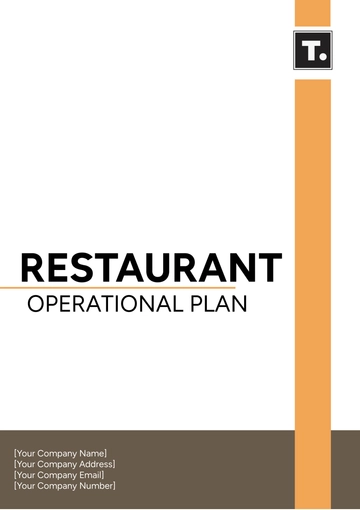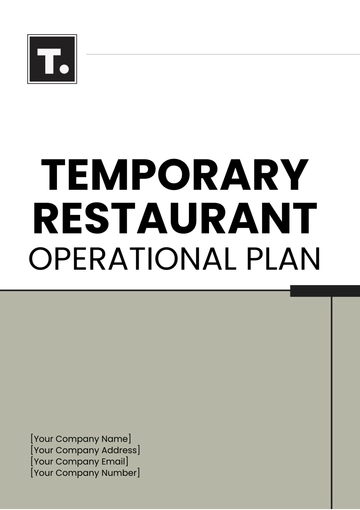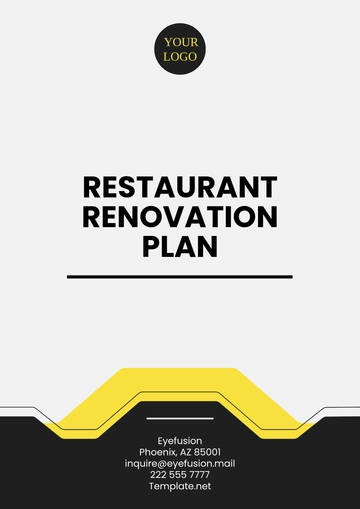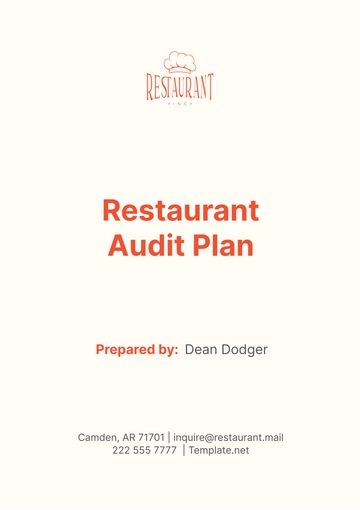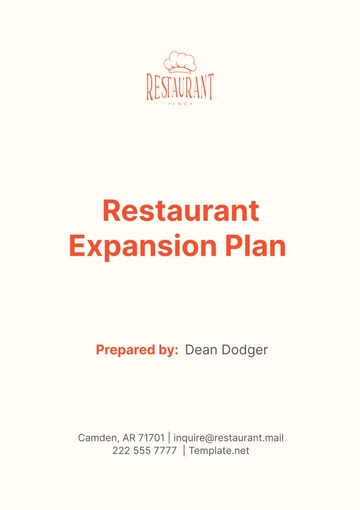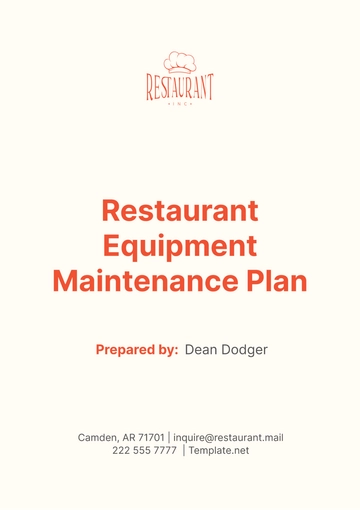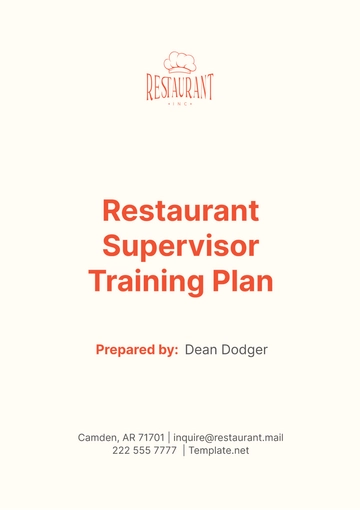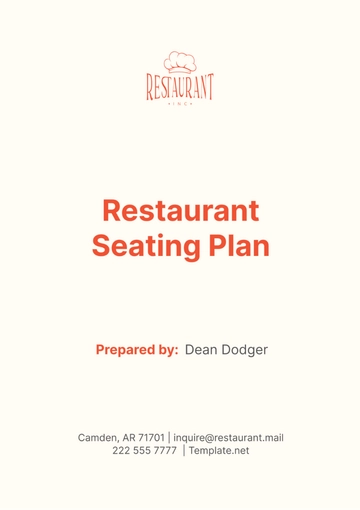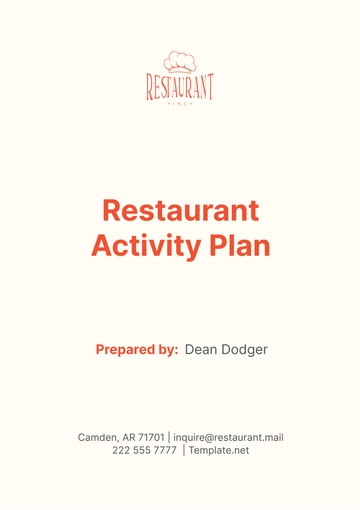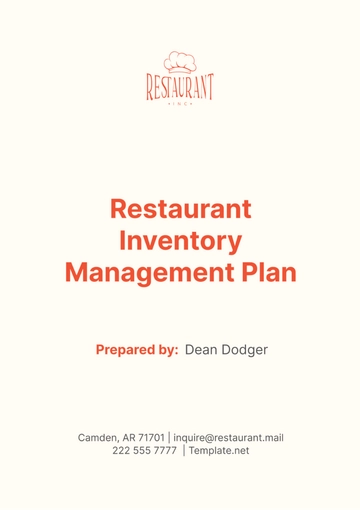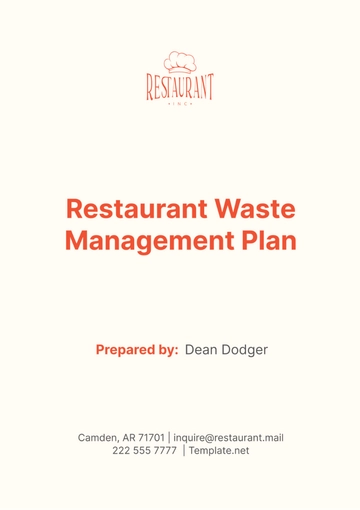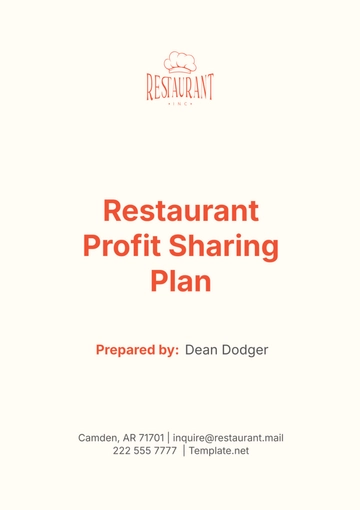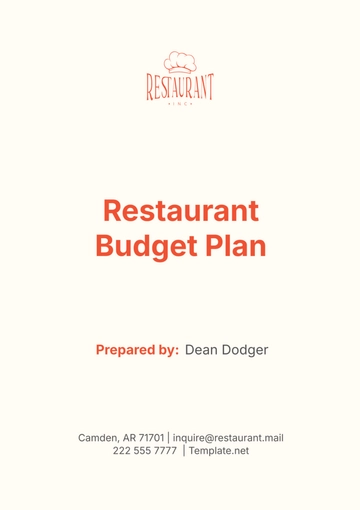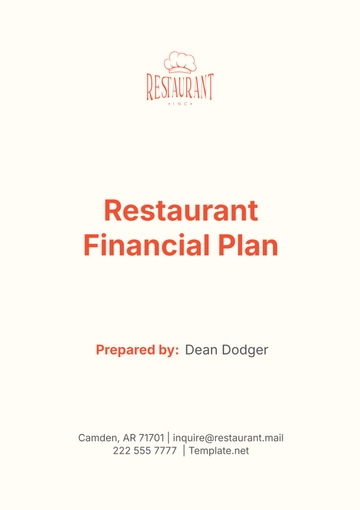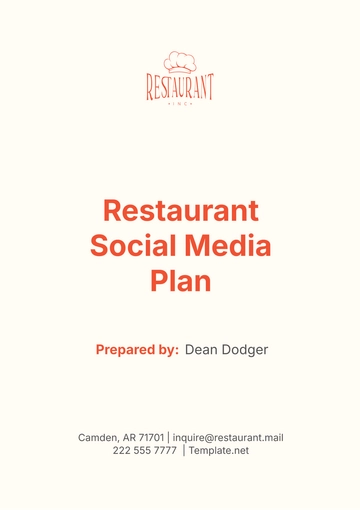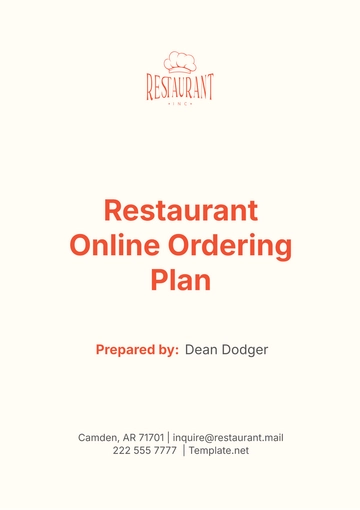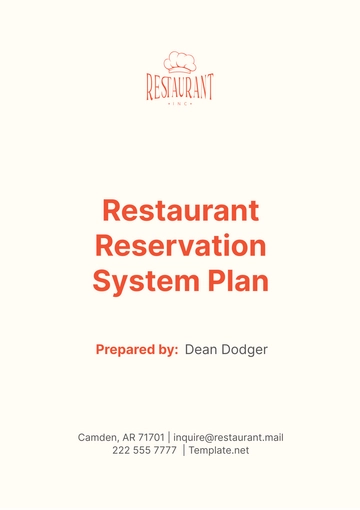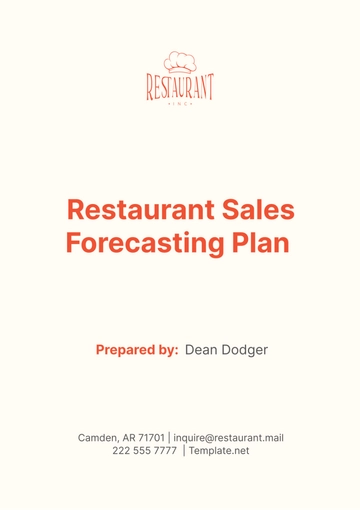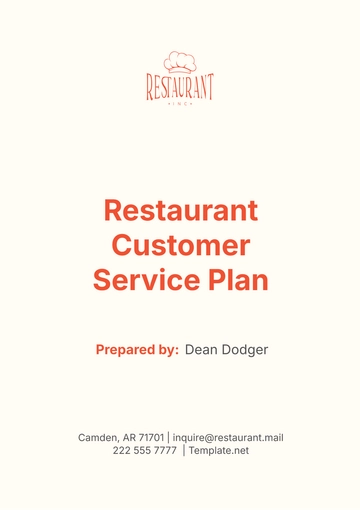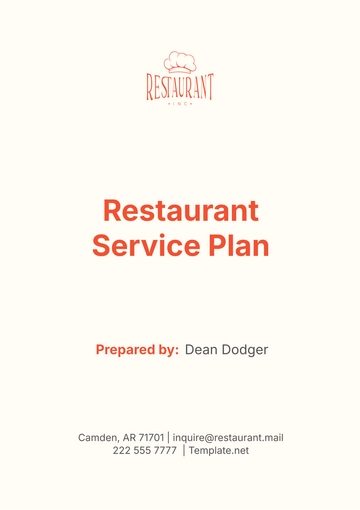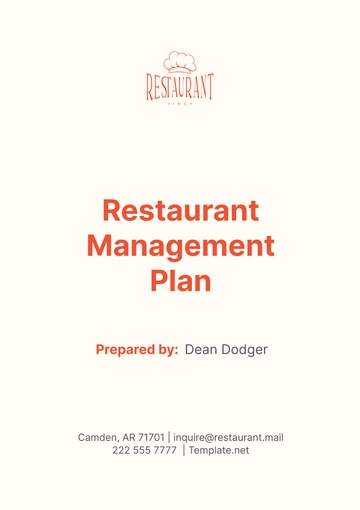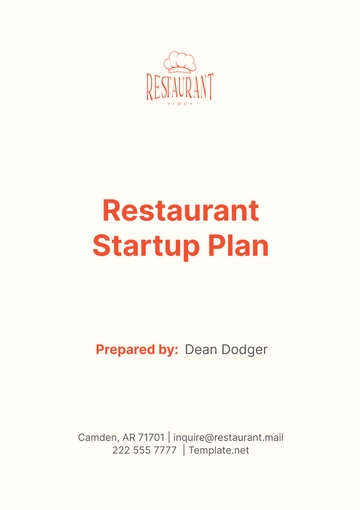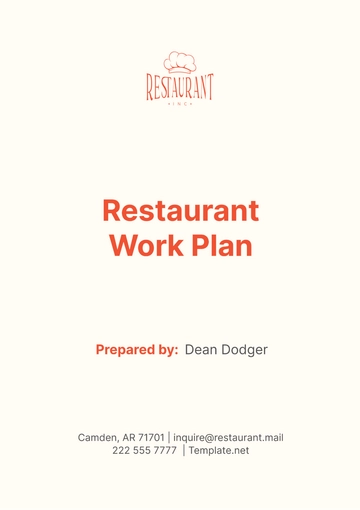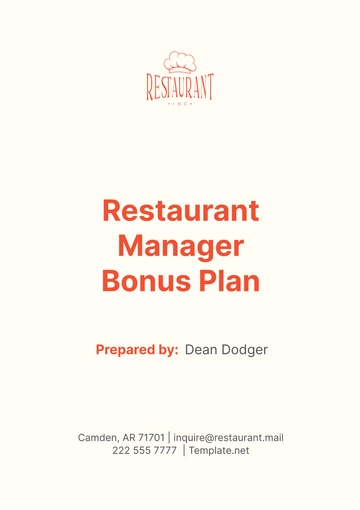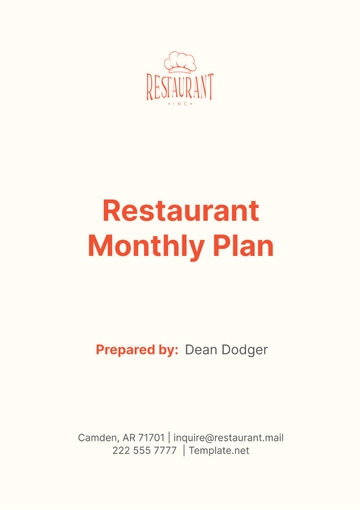Free Restaurant Operational Plan
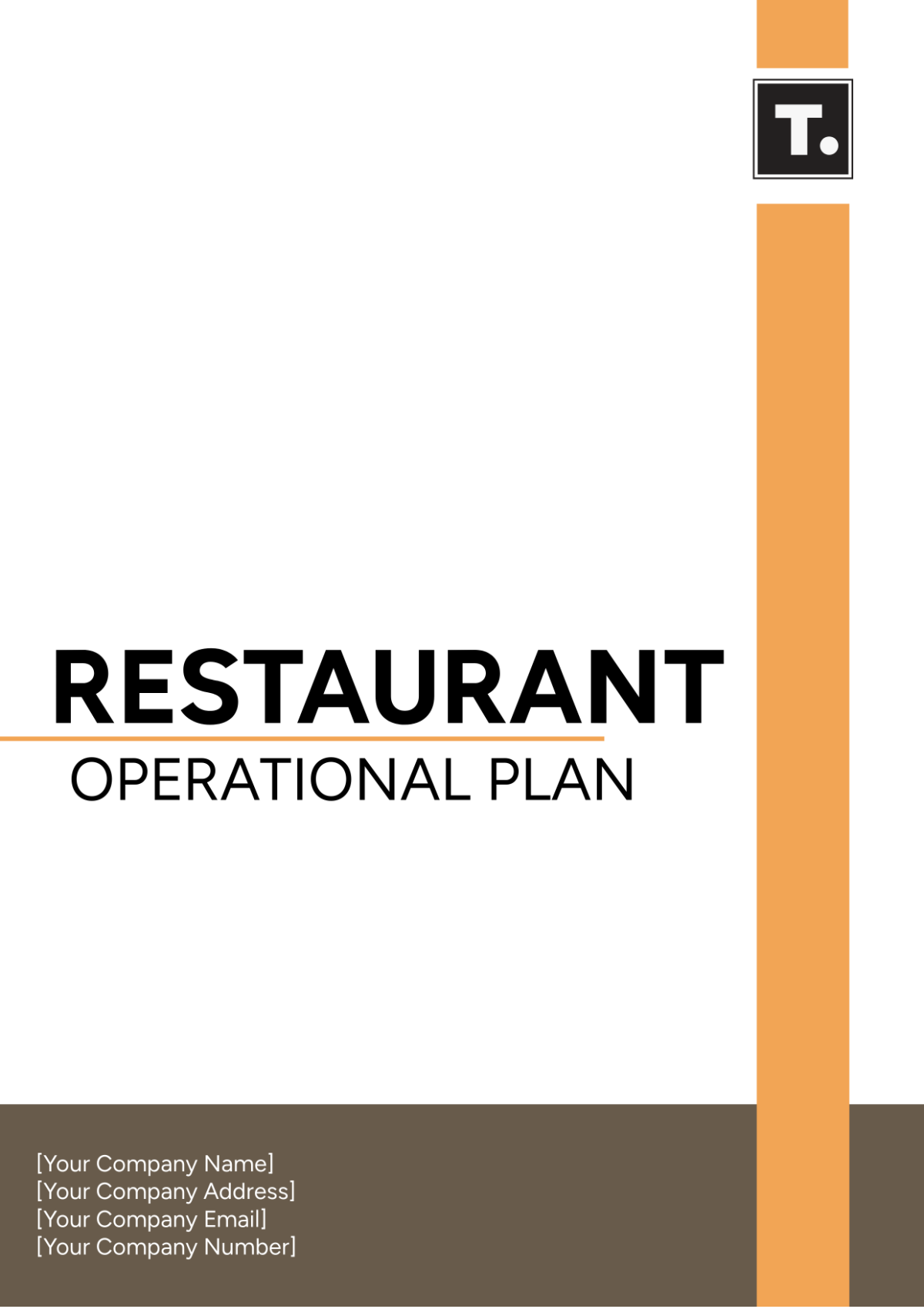
Prepared by: | [Your Name] |
Company: | [Your Company Name] |
Date: | [Date] |
I. Executive Summary
The Restaurant Operational Plan outlines the strategies, processes, and actions required for efficient management from January 2050 onward. The primary objective is to streamline operations, optimize resources, and deliver a high-quality dining experience to achieve sustained success and customer satisfaction. This plan covers staffing, inventory management, customer service, marketing, and financial management.
II. Staffing
A. Recruitment and Hiring
Job Descriptions: Create clear and detailed job descriptions for all positions, including cooks, servers, and managers. Each description should outline responsibilities, qualifications, and expected performance standards.
Hiring Process: Develop a structured hiring process. For example, new hires must complete an online application by January 15, 2050, followed by interviews scheduled between January 20 and February 1, 2050. Use a combination of behavioral and technical questions to assess candidates.
Onboarding: Implement an onboarding program. New employees will undergo orientation and training sessions during their first week, starting on February 5, 2050. Orientation will cover company culture, job-specific training, and a tour of the restaurant.
B. Training and Development
Initial Training: Conduct comprehensive initial training covering job-specific skills, company policies, and customer service standards. Training sessions will be held on the first Monday of each month and will include role-playing scenarios and hands-on practice.
Ongoing Training: Schedule ongoing training workshops every quarter, with the next session planned for April 10, 2050. Topics will include advanced culinary techniques, customer service excellence, and emergency procedures.
Performance Reviews: Conduct bi-annual performance reviews. The first round of reviews will take place from June 1 to June 15, 2050. Reviews will assess employee performance against set goals and provide feedback for improvement.
C. Scheduling and Shift Management
Shift Planning: Use scheduling software to create monthly shift plans. Publish schedules by the 25th of each month for the following month. Ensure shifts are balanced to prevent overworking staff and maintain service quality.
Shift Flexibility: Implement a shift swap policy allowing employees to trade shifts with a 48-hour notice. This policy will be reviewed quarterly. A digital platform will be used to facilitate shift swaps and ensure transparency.
D. Employee Retention and Engagement
Work Environment: Promote a positive and inclusive work environment. Host monthly team-building activities, with the next event on March 3, 2050. Activities will include team dinners, outdoor activities, and workshops.
Recognition Programs: Launch a recognition program starting in May 2050 to reward outstanding performance, including "Employee of the Month." Awards will be based on peer nominations and management evaluations.
Career Development: Provide career development workshops twice a year, with the next workshop scheduled for September 5, 2050. Topics will include leadership skills, time management, and career path planning.
E. Staffing Schedule
Date | Activity |
|---|---|
January 15, 2050 | Application Deadline |
January 20 - February 1, 2050 | Interview Period |
February 5, 2050 | New Employee Orientation |
March 3, 2050 | Team-building Activity |
April 10, 2050 | Quarterly Training Workshop |
June 1-15, 2050 | Performance Reviews |
September 5, 2050 | Career Development Workshop |
III. Inventory Management
A. Inventory Procurement
Supplier Selection: Evaluate and select reliable suppliers by March 1, 2050. Criteria will include product quality, reliability, and cost. Establish long-term partnerships to ensure consistency.
Order Scheduling: Establish a regular ordering schedule. Place orders every Monday and Thursday to maintain optimal inventory levels. Use historical data to predict needs and avoid overstocking.
B. Inventory Control
Inventory Tracking: Implement inventory management software by April 1, 2050, to monitor stock levels and track usage. This software will provide real-time data and alerts for low stock levels.
Waste Reduction: Develop waste reduction strategies, including weekly inventory audits starting on May 1, 2050. Strategies will include portion control, proper storage techniques, and using a first-in, first-out system.
C. Supplier Relationships
Communication: Maintain open communication with suppliers. Schedule quarterly meetings, with the first meeting on June 10, 2050. Discuss any issues and plan for future needs.
Negotiation: Negotiate favorable terms and prices with suppliers annually. The next negotiation round is planned for November 2050. Focus on securing discounts for bulk orders and long-term contracts.
D. Inventory Management Schedule
Date | Activity |
|---|---|
March 1, 2050 | Supplier Selection |
April 1, 2050 | Implement Inventory Management Software |
May 1, 2050 | Start Weekly Inventory Audits |
June 10, 2050 | Quarterly Supplier Meeting |
November 2050 | Annual Supplier Negotiations |
IV. Customer Service
A. Customer Experience
Service Standards: Establish high standards for customer service. Train all staff to meet these standards during the April 10, 2050 training session. Standards will include greeting customers promptly, handling requests efficiently, and ensuring a pleasant dining experience.
Ambiance: Create a welcoming and comfortable dining atmosphere. Redecorate the dining area by June 1, 2050. Consider lighting, music, and decor to enhance the ambiance.
Menu Quality: Regularly update the menu. Introduce seasonal dishes with the next update planned for July 1, 2050. Ensure dishes are prepared with fresh, high-quality ingredients.
B. Feedback and Complaint Handling
Feedback Channels: Provide multiple channels for customers to give feedback, including online surveys and comment cards available at each table. Encourage customers to share their dining experiences.
Complaint Resolution: Develop a process for promptly addressing and resolving customer complaints. Train staff to handle complaints professionally and empathetically. Review and refine the process quarterly.
C. Loyalty Programs
Rewards Program: Implement a loyalty program starting August 1, 2050, to reward repeat customers. Offer points for each visit that can be redeemed for discounts or free items.
Customer Engagement: Engage with customers through personalized offers and promotions. Launch a monthly newsletter starting September 1, 2050. Include exclusive deals, upcoming events, and new menu items.
D. Customer Service Improvement Plan
Date | Activity |
|---|---|
April 10, 2050 | Staff Training on Service Standards |
June 1, 2050 | Redecorate Dining Area |
July 1, 2050 | Introduce Seasonal Menu Items |
August 1, 2050 | Launch Loyalty Program |
September 1, 2050 | Start Monthly Customer Newsletter |
V. Marketing
A. Market Analysis
Target Market: Identify the target market and understand their preferences and dining habits by February 1, 2050. Use surveys and market research reports to gather data.
Competitive Analysis: Analyze competitors to identify opportunities and threats. Complete the first analysis by March 1, 2050. Focus on competitor pricing, menu offerings, and marketing strategies.
B. Marketing Strategies
Brand Identity: Develop a strong brand identity that resonates with the target market. Finalize branding materials by April 15, 2050. Include logo, tagline, and brand colors.
Advertising: Use a mix of traditional and digital advertising methods. Launch a new advertising campaign on May 1, 2050. This will include print ads, social media campaigns, and local radio spots.
C. Digital Marketing
Social Media: Leverage social media platforms to engage with customers. Post daily updates and promotional content starting January 1, 2050. Use engaging visuals and interact with followers.
Website and SEO: Maintain an up-to-date website with SEO practices to enhance online visibility. Conduct monthly website reviews to ensure content is current and optimized.
Online Reviews: Encourage satisfied customers to leave positive online reviews. Implement this strategy by March 1, 2050. Respond to all reviews promptly to show appreciation and address any concerns.
D. Promotions and Events
Special Offers: Create special offers and discounts to attract new customers. Plan quarterly promotions, with the first one starting on April 1, 2050. Offers will include discounts for new customers and limited-time menu items.
Events: Host events such as themed nights or live music. Schedule events monthly, starting with a Jazz Night on June 15, 2050. Promote events through social media and local advertising.
E. Marketing Activity Schedule
Date | Activity |
|---|---|
February 1, 2050 | Complete Target Market Analysis |
March 1, 2050 | Complete Competitive Analysis |
April 15, 2050 | Finalize Branding Materials |
May 1, 2050 | Launch Advertising Campaign |
March 1, 2050 | Start Encouraging Online Reviews |
June 15, 2050 | Host Jazz Night Event |
VI. Financial Management
A. Budgeting
Expense Planning: Create detailed budgets for all aspects of the restaurant, including staffing, inventory, and marketing. Finalize the budget for 2050 by January 10, 2050. Review and adjust the budget quarterly.
Financial Goals: Set clear financial goals and regularly review progress. Conduct monthly financial reviews on the 5th of each month. Goals will include revenue targets, cost reduction, and profit margins.
B. Cost Control
Expense Monitoring: Monitor expenses closely to identify and eliminate unnecessary costs. Implement cost control measures by February 15, 2050. This will include energy-saving practices, bulk purchasing, and waste reduction.
Profit Margins: Ensure pricing strategies maintain healthy profit margins. Review pricing quarterly, with the next review on April 1, 2050. Adjust menu prices based on cost analysis and market trends.
C. Financial Reporting
Regular Reporting: Generate regular financial reports to track performance and make informed decisions. Prepare monthly reports by the 10th of each month. Include income statements, balance sheets, and cash flow statements.
KPIs: Use key performance indicators (KPIs) to measure financial health. Establish KPIs by March 1, 2050, and review them quarterly. KPIs will include sales growth, profit margins, and customer acquisition costs.
D. Profitability Analysis
Revenue Analysis: Analyze revenue streams to identify the most profitable areas of the business. Conduct the first analysis by June 1, 2050. Focus on menu items, peak dining times, and customer demographics.
Cost-Benefit Analysis: Conduct cost-benefit analyses for major expenses and investments. Schedule analyses twice a year, with the next one on September 1, 2050. Evaluate the return on investment for marketing campaigns, equipment purchases, and staff training programs.
E. Financial Management Schedule
Date | Activity |
|---|---|
January 10, 2050 | Finalize 2050 Budget |
February 15, 2050 | Implement Cost Control Measures |
March 1, 2050 | Establish KPIs |
April 1, 2050 | Quarterly Pricing Review |
June 1, 2050 | Conduct Revenue Analysis |
September 1, 2050 | Conduct Cost-Benefit Analysis |
VII. Conclusion
The Restaurant Operational Plan serves as a comprehensive guide to ensure efficient management and sustained success from 2050 onward. By implementing the strategies outlined in this plan, the restaurant will optimize resources, enhance customer satisfaction, and achieve its business objectives. Regular review and adaptation of this plan will help the restaurant stay competitive and responsive to market changes. The first annual review of this plan is scheduled for December 1, 2050.
- 100% Customizable, free editor
- Access 1 Million+ Templates, photo’s & graphics
- Download or share as a template
- Click and replace photos, graphics, text, backgrounds
- Resize, crop, AI write & more
- Access advanced editor
Enhance your restaurant's efficiency with the Restaurant Operational Plan Template from Template.net. This editable and customizable tool provides a comprehensive framework for streamlined operations. Tailor it to your needs using our Ai Editor Tool, ensuring flexibility and precision in planning. Elevate success with this professionally crafted template, designed to meet the unique demands of the food service industry.
You may also like
- Finance Plan
- Construction Plan
- Sales Plan
- Development Plan
- Career Plan
- Budget Plan
- HR Plan
- Education Plan
- Transition Plan
- Work Plan
- Training Plan
- Communication Plan
- Operation Plan
- Health And Safety Plan
- Strategy Plan
- Professional Development Plan
- Advertising Plan
- Risk Management Plan
- Restaurant Plan
- School Plan
- Nursing Home Patient Care Plan
- Nursing Care Plan
- Plan Event
- Startup Plan
- Social Media Plan
- Staffing Plan
- Annual Plan
- Content Plan
- Payment Plan
- Implementation Plan
- Hotel Plan
- Workout Plan
- Accounting Plan
- Campaign Plan
- Essay Plan
- 30 60 90 Day Plan
- Research Plan
- Recruitment Plan
- 90 Day Plan
- Quarterly Plan
- Emergency Plan
- 5 Year Plan
- Gym Plan
- Personal Plan
- IT and Software Plan
- Treatment Plan
- Real Estate Plan
- Law Firm Plan
- Healthcare Plan
- Improvement Plan
- Media Plan
- 5 Year Business Plan
- Learning Plan
- Marketing Campaign Plan
- Travel Agency Plan
- Cleaning Services Plan
- Interior Design Plan
- Performance Plan
- PR Plan
- Birth Plan
- Life Plan
- SEO Plan
- Disaster Recovery Plan
- Continuity Plan
- Launch Plan
- Legal Plan
- Behavior Plan
- Performance Improvement Plan
- Salon Plan
- Security Plan
- Security Management Plan
- Employee Development Plan
- Quality Plan
- Service Improvement Plan
- Growth Plan
- Incident Response Plan
- Basketball Plan
- Emergency Action Plan
- Product Launch Plan
- Spa Plan
- Employee Training Plan
- Data Analysis Plan
- Employee Action Plan
- Territory Plan
- Audit Plan
- Classroom Plan
- Activity Plan
- Parenting Plan
- Care Plan
- Project Execution Plan
- Exercise Plan
- Internship Plan
- Software Development Plan
- Continuous Improvement Plan
- Leave Plan
- 90 Day Sales Plan
- Advertising Agency Plan
- Employee Transition Plan
- Smart Action Plan
- Workplace Safety Plan
- Behavior Change Plan
- Contingency Plan
- Continuity of Operations Plan
- Health Plan
- Quality Control Plan
- Self Plan
- Sports Development Plan
- Change Management Plan
- Ecommerce Plan
- Personal Financial Plan
- Process Improvement Plan
- 30-60-90 Day Sales Plan
- Crisis Management Plan
- Engagement Plan
- Execution Plan
- Pandemic Plan
- Quality Assurance Plan
- Service Continuity Plan
- Agile Project Plan
- Fundraising Plan
- Job Transition Plan
- Asset Maintenance Plan
- Maintenance Plan
- Software Test Plan
- Staff Training and Development Plan
- 3 Year Plan
- Brand Activation Plan
- Release Plan
- Resource Plan
- Risk Mitigation Plan
- Teacher Plan
- 30 60 90 Day Plan for New Manager
- Food Safety Plan
- Food Truck Plan
- Hiring Plan
- Quality Management Plan
- Wellness Plan
- Behavior Intervention Plan
- Bonus Plan
- Investment Plan
- Maternity Leave Plan
- Pandemic Response Plan
- Succession Planning
- Coaching Plan
- Configuration Management Plan
- Remote Work Plan
- Self Care Plan
- Teaching Plan
- 100-Day Plan
- HACCP Plan
- Student Plan
- Sustainability Plan
- 30 60 90 Day Plan for Interview
- Access Plan
- Site Specific Safety Plan


